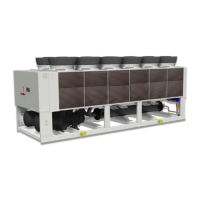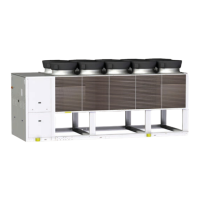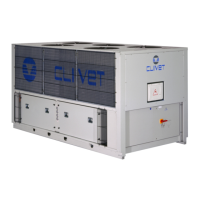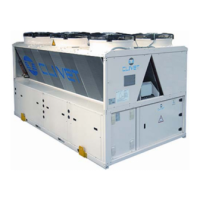
Do you have a question about the CLIVET WDAT-SL3 FC 200.2 and is the answer not in the manual?
Guidelines on manual usage, qualifications, and risk awareness.
Proper unit usage, safety guidelines, and modification warnings.
Procedures for handling unit breakdowns and malfunctions.
User training needs and unit identification procedures.
Steps for safe unit handling, lifting, and stability checks.
Requirements for functional spaces and criteria for unit positioning.
Acceptable water quality limits and consequences of poor quality.
Measures to prevent freezing and guidance on anti-freeze solutions.
Guidelines for component type and position in hydraulic systems.
Water filter importance and hydraulic circuit operation steps.
Unit electrical data and steps for making connections.
Specifications for power supply cable cross-sections.
Steps for connecting and configuring a PC for unit control.
Details on connecting and operating the remote control option.
Requirements and guidelines for Modbus-RS485 communication.
Details on LonWorks and BACnet IP communication protocols.
Overview of start-up, required qualifications, and pre-checks.
Step-by-step procedure for starting the unit.
Verification steps for refrigeration and water circuits before start-up.
Electrical circuit verification and voltage checks during operation.
Procedure for setting electrical power demand limits.
Procedure for configuring climatic text parameters.
Procedure for setting water reset parameters.
Details on ECOSHARE for automatic management of multiple units.
Descriptions of unit operation modes A, B, and C in a network.
Checks for water flow-rate, start-up report, and reduced load operation.
Explanation of control panel indicators, display variables, and key functions.
Procedures to change unit state (ON/OFF/ECO) and operating mode (Cool/Heat).
Procedure for adjusting setpoint values for the unit.
Displaying unit status and configuring the automatic scheduler.
Managing alarms and a comprehensive list of alarm codes.
Overview of maintenance requirements, safety, and precautions.
Recommended inspection intervals and specific checks.
Procedures for cleaning and maintaining the water side exchanger.
Checks for circulating pumps, flow switch, and electric fans.
Instructions for cleaning the air coil and its fins.
Periodic checks for screw compressors based on operating hours.
Procedure for system discharge and handling of liquids.
Codes and descriptions for central module status.
Codes and descriptions for circuit 1 status.
Status codes for Thermostatic C1 and Recovery Circuit 1.
Status codes for master slave units and hydronic modules.
Status codes related to energy meter readings.
Diagrams and conditions for direct FREE-COOLING operation.
Diagrams and conditions for no-glycol FREE-COOLING operation.
Description of the partial energy recovery device and its function.
Description of total energy recovery modes and operation.
Details of the HydroPack unit's automatic logic activation.
Information on anti-vibration mount support selection.
Procedures for safely disconnecting, dismantling, and disposing of the unit.
Information on disposal compliance with the EC RAEE directive.
Common risks from electric parts, handling, and general situations.
Risks from moving parts, fans, and refrigerant leaks.
Performance metrics for SC configuration across various parameters.
Performance metrics for EN configuration across various parameters.
Construction specifications for SC configuration (compressors, fans, etc.).
Construction specifications for EN configuration (compressors, fans, etc.).
Unit operating ranges and sound levels for SC configuration.
Unit operating ranges and sound levels for EN configuration.
Water flow rate limits and fouling correction factors.
Exchanger operating range and device calibration values.
Dimensional drawings for SC configuration models 200.2-210.2.
Dimensional drawings for EN configuration models 200.2-210.2.










